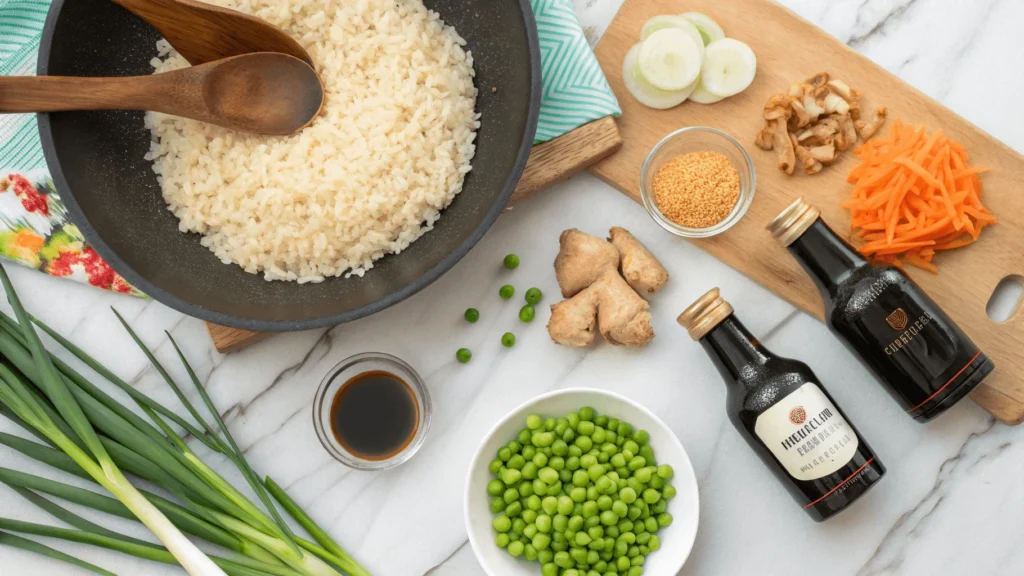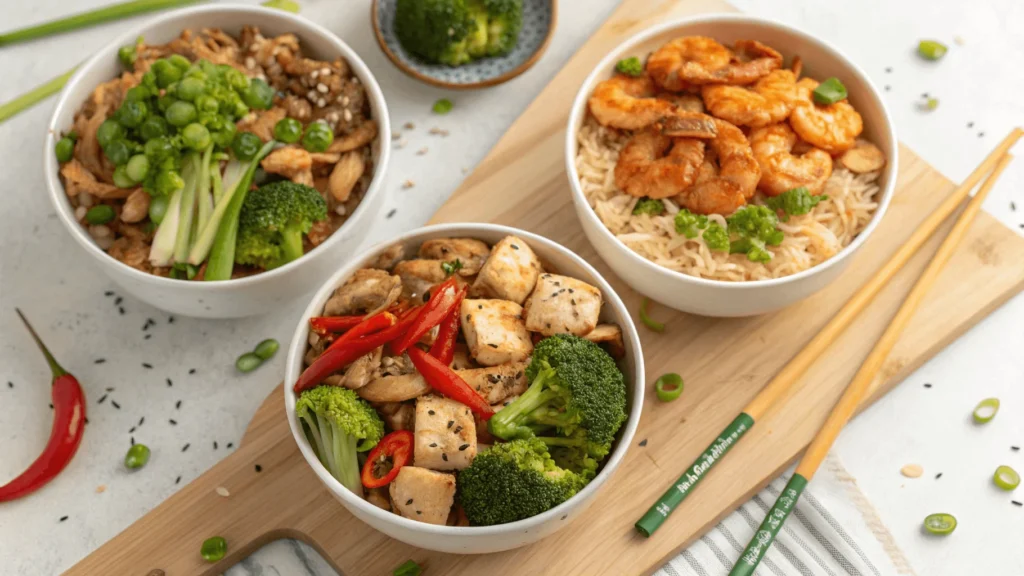Chinese restaurant fried rice is undeniably beloved, celebrated for its rich flavors, perfect texture, and smoky aroma. Not only is it a staple in Chinese cuisine, but it’s also a favorite across the globe, bringing people together through its comforting taste. So, what exactly makes it so irresistibly delicious? To answer this, let’s delve into its fascinating elements to uncover the magic behind this iconic dish.
First of all, the foundation of great fried rice lies in its simplicity and versatility. For instance, it starts with day-old rice, which is drier and less sticky, allowing it to fry up perfectly without becoming mushy. Additionally, the use of high heat in a well-seasoned wok creates that signature smoky flavor, known as wok hei, which is difficult to replicate at home but achievable with the right technique. Moreover, the balance of flavors—savory soy sauce, umami-rich oyster sauce, and a hint of sweetness—adds depth and complexity to every bite.
By understanding the secret ingredient in Chinese fried rice, mastering cooking techniques, and embracing the cultural essence that elevates its taste, you’ll discover why it continues to captivate palates worldwide.
Chinese Restaurant Fried Rice
Fried rice is far more than a simple stir-fry of rice, vegetables, and protein. At its core, it’s a balance of flavors, textures, and techniques. Whether served as a main course or a side dish, Chinese fried rice is crafted with a combination of precise cooking methods and carefully selected ingredients.
The restaurant version, however, has a distinct flavor and texture that’s hard to replicate at home. The secret lies in professional techniques like high heat cooking (wok hei), the use of soy sauce, and perfectly chilled, day-old rice. Understanding these nuances will help uncover why Chinese restaurant fried rice tastes so good.
For a deeper dive into similar culinary techniques, explore mastering the restaurant fried rice secret at home, which reveals tips to recreate these professional methods in your kitchen.
The Cultural Roots of Chinese Restaurant Fried Rice
History and Evolution of The Secret Ingredient to Restaurant Fried Rice
Chinese fried rice has a rich history dating back thousands of years. To begin with, it originated during the Sui Dynasty (589–618 CE), when it was created as a practical solution to use leftover rice and ingredients efficiently. This simple yet ingenious idea not only minimized food waste but also transformed humble leftovers into a flavorful and satisfying dish.
Key aspects of its evolution:
- Traditional leftovers: Initially made to avoid wasting rice and scraps of meat or vegetables.
- Adaptability: The dish evolved with regional variations, each incorporating local ingredients and flavors.
- Popularity abroad: Chinese immigrants introduced fried rice to different countries, where it adapted to local tastes.
Today, fried rice is a global favorite, celebrated for its versatility and delightful taste.
Regional Variations of The Secret Ingredient to Restaurant Fried Rice
Chinese fried rice is not a monolithic dish. Each region in China brings its own flavor profile and ingredients to the table:
- Yangzhou Fried Rice: Known for its use of shrimp, roast pork, and eggs, this dish is a symbol of elegance in Chinese cuisine.
- Cantonese Fried Rice: Features sweeter soy sauce and a mix of fresh vegetables and meats.
- Sichuan Fried Rice: Spicy and bold, often incorporating chili oil or Sichuan peppercorns.
Each version reflects the adaptability of fried rice, showcasing its versatility across cultures. To achieve such regional flavors at home, consider what gives Chinese fried rice its flavor, which highlights ingredients and techniques pivotal to authenticity.
Unlocking the Flavor Secrets of Chinese Restaurant Fried Rice

Essential Rice Types Used in Chinese Cooking
The foundation of any great fried rice is, of course, the rice. Chinese restaurant fried rice relies on specific types to achieve its characteristic flavor and texture:
- Day-old rice: Freshly cooked rice is too moist and sticky. Day-old rice, stored in the refrigerator, firms up and separates, making it perfect for stir-frying.
- Long-grain rice: Jasmine rice is a favorite because it’s less sticky and has a subtle aroma.
- Short-grain rice: Sometimes used for heartier versions, but it can be harder to achieve the ideal texture.
Signature Ingredients and Seasonings
The secret ingredient to restaurant fried rice lies not only in the perfect combination of seasonings but also in the careful use of aromatics. Together, these elements gradually build layers of flavor, enhancing every bite with a depth that sets it apart from homemade versions. Moreover, they work in harmony to deliver the signature taste we all crave, ensuring that each grain of rice is infused with savory, umami-rich goodness. By thoughtfully balancing these components, professional chefs consistently achieve the irresistible appeal of restaurant-style fried rice.
Soy Sauce: The Backbone of Flavor
Soy sauce plays a vital role in fried rice, adding:
- Umami depth: This savory flavor enhancer elevates the dish.
- Color: It gives fried rice its classic golden-brown hue.
- Versatility: Light soy sauce provides a salty kick, while dark soy sauce adds sweetness and color.
Aromatics: Garlic, Ginger, and Green Onion
No fried rice is complete without these key aromatics:
- Garlic: Adds a pungent, slightly sweet aroma.
- Ginger: Provides a warming, zesty flavor.
- Green onion: Balances the richness with a fresh, sharp taste.
Together, these elements form the base of the dish’s complex flavor profile.
Techniques to Recreate Chinese Restaurant Fried Rice
Importance of High Heat (Wok Hei)
The wok hei (breath of the wok) is the hallmark of Chinese restaurant fried rice. This technique involves:
- Using high heat: Achieves a charred, smoky flavor that’s hard to replicate with home stovetops.
- Quick cooking: Prevents overcooking while locking in flavor and texture.
- Constant tossing: Ensures even cooking and prevents sticking.
Mastering wok hei is essential to creating the signature restaurant flavor.

Mastering the Stir-Fry Method
The stir-fry method is another critical technique for making fried rice:
- Prepare ingredients in advance: Ensure everything is chopped, measured, and ready to go.
- Heat the wok until smoking: This ensures proper caramelization of the ingredients.
- Cook in stages: Start with aromatics, then add proteins, vegetables, and rice.
- Stir constantly: Keep the ingredients moving to prevent burning and ensure even cooking.
Why Restaurant Equipment Enhances the Flavor of Fried Rice
The Role of Commercial Woks
Restaurant kitchens rely on commercial woks, which play a significant role in achieving the perfect fried rice:
- Material: Carbon steel woks heat up quickly and evenly, allowing for precise cooking.
- Shape: The rounded bottom concentrates heat and facilitates tossing.
- Size: Larger woks allow chefs to cook multiple servings at once without crowding.
Specialized Tools and Their Impact
Beyond woks, other specialized tools help enhance the flavor:
- Powerful burners: Deliver the intense heat needed for wok hei.
- Spatulas and ladles: Designed for quick stirring and tossing.
- Rice cookers: Ensure perfectly cooked rice as a base for fried rice.
These tools, combined with expert techniques, make all the difference in the final dish.
Timing and Preparation in Professional Kitchens
Creating restaurant-quality fried rice at home may seem challenging at first, but it becomes entirely achievable with careful timing and meticulous preparation. In fact, these two factors are the hallmarks of professional kitchens, where every detail is finely tuned for efficiency and consistency. From the way ingredients are thoroughly prepped in advance to the precise sequence in which they are cooked, each step plays a crucial role in ensuring maximum flavor.
Pre-Cooking and Chilling the Rice
The foundation of fried rice lies in properly prepared rice. Restaurants achieve the perfect texture by pre-cooking rice and chilling it overnight.
- Why chill the rice?
- Chilling firms up the grains, preventing clumping and sogginess.
- It allows the rice to absorb flavors better when stir-fried.
- How to prepare the rice:
- Use long-grain or jasmine rice for optimal fluffiness.
- Rinse the rice thoroughly before cooking to remove excess starch.
- Spread the cooked rice on a baking sheet to cool quickly, then refrigerate.
Mise en Place: Ready Ingredients for Speed and Flavor
Professional chefs rely on mise en place, or “everything in its place,” to streamline cooking. This practice involves organizing and preparing all ingredients before starting to cook, ensuring a smooth and efficient process.
- Steps for mise en place:
- Dice vegetables, proteins, and aromatics beforehand.
- Measure sauces like soy sauce, sesame oil, and oyster sauce into small bowls.
- Keep tools like spatulas and ladles within reach.
Having all ingredients prepped ensures the rapid cooking process essential for fried rice. To begin with, fried rice is best cooked quickly over high heat, which means there’s no time to chop vegetables or measure sauces once you start cooking.
Personalizing Fried Rice for Unique Flavors
One of the joys of fried rice is its adaptability. Personalizing the dish allows home cooks to experiment with flavors and ingredients.

Adding Protein: Eggs, Shrimp, and More
Protein transforms fried rice into a hearty meal. Whether you’re craving vegetarian, seafood, or meaty options, the possibilities are endless.
- Eggs: The classic choice, scrambled eggs add richness and texture.
- Shrimp: Fresh or frozen shrimp provide sweetness and a touch of luxury.
- Chicken or pork: Dice or shred cooked meat for easy incorporation.
- Tofu: For a vegetarian twist, pan-fried tofu cubes work beautifully.
Creative Vegetable Choices
Vegetables not only add nutrition but also vibrant colors and textures.
- Common choices: Carrots, peas, and green onions are staples.
- Creative options:
- Broccoli florets or bok choy for added crunch.
- Corn kernels for sweetness.
- Bell peppers for a mild kick.
Experimenting with vegetables ensures variety in every bite, and it also adds layers of flavor and texture that elevate the dish.
Balancing Flavors: The Key to Professional Results
The key to restaurant fried rice lies in achieving a harmonious balance of flavors. In fact, this balance is what distinguishes professional dishes from homemade versions. Notably, Chinese cuisine emphasizes the interplay of different taste profiles, which ensures every bite is both satisfying and complex. Moreover, understanding these profiles helps you elevate your dish beyond the ordinary.
The Five Flavors in Chinese Cuisine
Mastering the balance of flavors ensures your fried rice has depth. To start, it’s important to layer your seasonings thoughtfully, beginning with aromatics like garlic, ginger, and green onion to build a strong foundation.
- Sweet: A touch of sugar or hoisin sauce balances savory notes.
- Salty: Soy sauce and fish sauce add the essential umami punch.
- Bitter: Lightly charred vegetables contribute subtle bitterness.
- Sour: A splash of rice vinegar brightens the dish.
- Spicy: Add heat with chili oil or fresh chili slices.
Achieving Umami Perfection
Umami, the elusive “fifth taste,” is the secret ingredient to restaurant fried rice.
- Sources of umami:
- Soy sauce or tamari
- Oyster sauce or fish sauce
- Mushrooms, especially shiitake or dried varieties
- Enhance umami with toasted sesame oil or garlic-infused oil for a finishing touch.
Avoiding Common Fried Rice Mistakes
Even seasoned cooks can make errors when replicating restaurant fried rice. Avoid these pitfalls for perfect results.
Overcrowding the Pan
One of the most common mistakes is overcrowding the pan, which leads to steaming instead of frying.
- Why this matters:
- A crowded pan prevents the high heat needed for caramelization.
- It causes uneven cooking and mushy textures.
- Solution:
- Cook in small batches.
- Use a wok or large skillet for ample space.
Using Fresh Rice Instead of Day-Old
Freshly cooked rice is too moist, leading to clumpy and sticky fried rice.
- Why day-old rice is better:
- The drying process separates grains, ensuring a light, fluffy texture.
- It absorbs sauces without becoming mushy.
- Quick tip: If you’re short on time, spread fresh rice on a tray and freeze for 15–20 minutes.
Tips to Replicate Restaurant-Style Fried Rice at Home
Replicating the iconic flavor of restaurant fried rice at home requires attention to detail and the right tools. Additionally, a well-seasoned wok or a large skillet is crucial for achieving the signature smoky flavor, known as wok hei, and even heat distribution, which is key to perfectly cooked fried rice. Moreover, cooking over high heat is vital to replicate the quick, intense cooking process used in restaurants, as it locks in flavors and creates the ideal texture.
Selecting the Right Ingredients
Using high-quality ingredients ensures superior results.
- Rice: Jasmine rice is ideal for its fragrance and texture.
- Soy sauce: Opt for light soy sauce for seasoning and dark soy sauce for color.
- Oils: Peanut oil or vegetable oil withstand high heat.
- Aromatics: Garlic, ginger, and green onions are essential.
Proper Tools and Techniques for Home Cooks
The tools you use can significantly impact the cooking process.
- Wok or large skillet:
- A wok’s unique shape allows for even heat distribution, making it an indispensable tool for cooking dishes like fried rice. The rounded bottom of the wok ensures that heat is concentrated at the center, while the sloping sides provide cooler areas where ingredients can be moved to prevent overcooking.
- High heat:
- Cook over high heat to achieve the characteristic smoky flavor, or wok hei, that defines exceptional fried rice. This high-heat cooking method is essential because it allows the ingredients to sear quickly, creating a slight char and infusing the dish with that unmistakable smoky aroma.
- Fast cooking:
- Constantly stirring ingredients is a crucial step in making perfect fried rice, as it prevents burning and ensures even cooking. When cooking over high heat, ingredients can quickly go from perfectly seared to burnt if left unattended. By continuously stirring and tossing, you distribute the heat evenly, allowing each component to cook uniformly without sticking to the wok or skillet.
FAQs About Chinese Fried Rice
Why is day-old rice better for fried rice?
Day-old rice has reduced moisture content, which is crucial for achieving the perfect texture in fried rice. When rice is freshly cooked, it tends to be soft and sticky, making it prone to clumping or turning mushy when stir-fried. However, after being refrigerated overnight, the rice grains firm up and lose some of their moisture, allowing them to remain separate and fluffy during cooking.
What is Wok Hei, and why is it important?
Wok hei, or “breath of the wok,” is the smoky, charred aroma that is highly sought after when cooking fried rice. To achieve this iconic flavor, it is essential to cook over very high heat, which allows the ingredients to sear quickly and develop their distinct smoky essence. This high-heat cooking technique not only locks in the flavors but also creates a slight charring on the rice and other ingredients, adding depth and complexity to the dish.
Can I use brown rice instead of white rice?
Indeed, brown rice not only adds a nutty flavor but also provides extra fiber, making it a healthier alternative. However, it is important to note that its firmer texture requires adjustments to cooking times. Therefore, you may need to simmer it slightly longer or use additional water to ensure the rice reaches the desired tenderness.
What’s the best soy sauce for fried rice?
Light soy sauce is best for seasoning, while dark soy sauce adds rich color. Low-sodium soy sauce works for those watching their salt intake.
Why does homemade fried rice often turn out mushy?
Mushy fried rice is often the result of using freshly cooked rice or overcrowding the pan, both of which significantly trap steam and interfere with proper frying. First of all, freshly cooked rice contains excess moisture that clumps the grains together, making it nearly impossible to achieve the desired fluffy texture. Furthermore, when the pan is overcrowded, the trapped steam prevents the rice and other ingredients from browning, leading to a soggy consistency.
Are there vegetarian options for Chinese fried rice?
Absolutely! In fact, incorporating tofu, mushrooms, and a variety of vegetables is an excellent way to create delicious vegetarian versions of fried rice. Moreover, these ingredients not only add unique flavors but also bring a satisfying texture to the dish. For instance, tofu can be pan-fried for a crispy exterior, while mushrooms, such as shiitake or button varieties, offer a savory umami boost.
Conclusion: The Irresistible Allure of Chinese Fried Rice
Chinese fried rice is a dish that not only transcends its humble origins but also offers endless opportunities for customization and flavor exploration. Moreover, when you take the time to master the art of preparation, carefully select your ingredients, and skillfully balance flavors, you can create fried rice that truly rivals the version from your favorite restaurant. In addition to its simplicity, the dish’s adaptability makes it a favorite across cultures, proving that with the right techniques, even a humble recipe can transform into something extraordinary.
Furthermore, remember that the secret ingredient to restaurant fried rice lies in the smallest yet most impactful details—whether it’s the proper use of day-old rice, the mastery of achieving wok hei, or the delicate art of balancing the five essential flavors. As a result, incorporating these tips into your cooking process will revolutionize your fried rice, elevating it from ordinary to unforgettable.


2 thoughts on “Why Does Chinese Restaurant Fried Rice Taste So Good? Unlock the Secret”